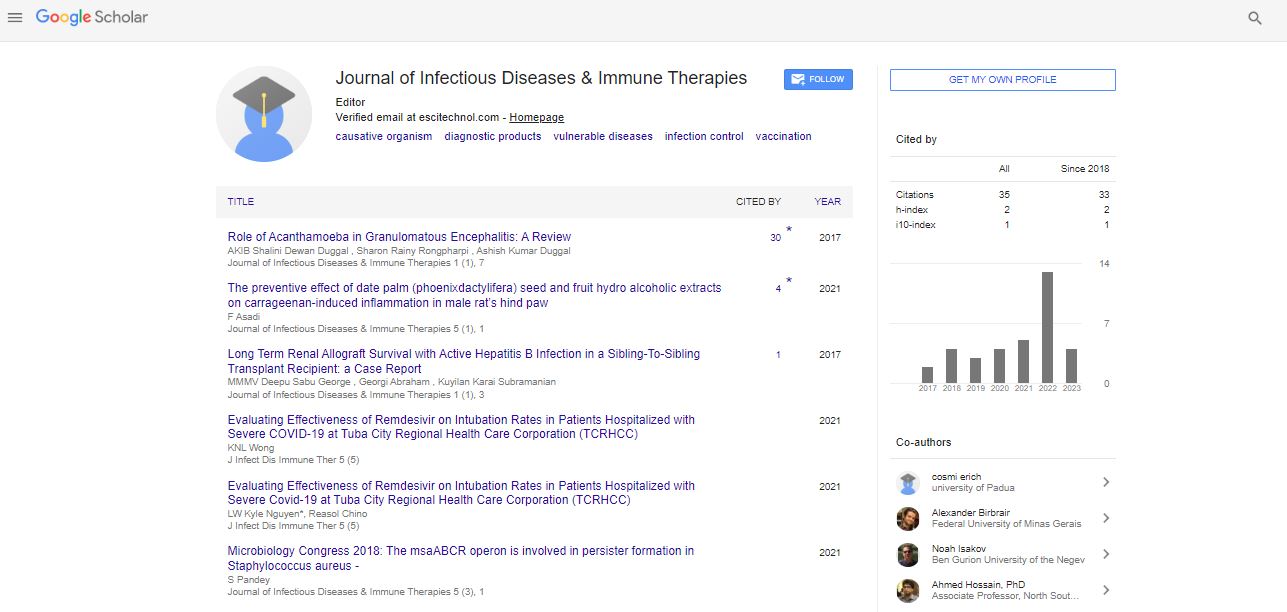Short Communication, J Infect Dis Immune Ther Vol: 5 Issue: 6
Infectious Diseases and Illnesses Caused by Organisms
Ahupathi Ballabh Narayana*
Department of Pulmonology, Kathmandu Medical College Teaching Hospital, Kathmandu, Nepal
*Corresponding Author : Ahupathi Ballabh Narayana Department of Pulmonology, Kathmandu Medical College Teaching Hospital, Kathmandu, Nepal, E-mail: narayanaballabh-ne-@nic.in
Received: November 01, 2021; Accepted: November 15, 2021; Published: November 22, 2021
Citation: Narayana AB (2021) Infectious Diseases and Illnesses Caused by Organisms. J Infect Dis Immune Ther 5: 6.
Abstract
Description
All living organisms can be divided into three categories: archaebacteria, eubacteria, and eukaryotes; although they differ in structure and compositions, they are all composed of cells as the fundamental life unit. At the molecular level, there's also an excellent deal of similarity within the basic materials that structure these entities because they use an equivalent sorts of molecules to store and reproduce information, from the cellular metabolism and machinery and to provide the structural framework [1]. Thus nucleic adds, proteins, lipid membranes, and carbohydrates alone and in various combinations are universally present, albeit in distinguishable forms, along with innumerable metabolites and ions.
There are components that are apparently essential for all times and are found in one form or another altogether species and there are many unique moieties and associated activities that are highly specialized and are found in relatively few organisms [2]. Indeed, the similarities have underpinned the development of our understanding of cellular function at a rudimentary level and the differences, basically engendered by evolution, have illustrated and delineated the complexity that speciation has introduced.
Perhaps the largest of these differences is that which separates single cell organisms from multicellular organisms. The latter are exclusively eukaryotes while the previous are composed of both eukaryotes and prokaryotes [3]. The cellular organization that distinguishes these two major life forms is striking although cell biology correctly embraces both, traditionally prokaryotic organisms are the province of the microbiologists and therefore the majority of cell biology research has been dedicated to the eukaryotic world. In practical terms this translates for the foremost part into the study of human cells and people of easily maintained laboratory animals and selected paradigms, for instance, fruit flies, worms, and zebra fish. Human and animal cell biology isn't a tightly proscribed science with well-defined borders.
Basically it serves at the interface between biochemistry, biology, and genetics, on the one hand, and anatomy and physiology, on the opposite. The continuum of those disciplines forms the core of the biomedical sciences, which also include the related but separate fields of pharmacology, microbiology, immunology, and pathology that provide the connections to disease and health. Cell biology has strong connections to all or any of those.
There also are specialized areas, for instance, neuroscience, that are of such importance that they warrant their own category and therefore the cell biology related to them is additionally highly specialized. Thus, cell biology is as complex because the enormous sort of cells that exist and achieving an accurate description of all of them in terms of their components and functions has long been a serious a part of the research during this field [4]. While all organisms can sense their environment and answer cues from it, multicellular organisms must additionally coordinate their responses, which require intercellular communication at a classy level.
The higher the event, the more complex these communication systems become. Thus the cell biologist must focus not only on how molecular function is translated into cell organization and the way these functions are coordinated from organelle to organelle but also on the external inter-actions and signals that control the larger functional responses of organs and ultimately organisms [5].
References
- Hoffman O, Weber RJ (2009) Pathophysiology and treatment of bacterial meningitis. Ther Adv Neurol Disord 2:1-7.
- Nigrovic LE, Kuppermann N, Malley R (2002) Development and validation of a multivariable predictive model to distinguish bacterial from aseptic meningitis in children in the post-haemophilus influenzae era. Pediatrics 110:712-9.
- Wenger JD, Hightower AW, Facklam RR, Gaventa S, Broome CV (1990) Bacterial meningitis in the United States, 1986: Report of a multistate surveillance study. The Bacterial Meningitis Study Group. J Infect Dis 162:1316-23.
- Stoll BJ, Hansen N, Fanaroff AA, Wright LL, Carlo WA, et al., (2004) To tap or not to tap: High likelihood of meningitis without sepsis among very low birth weight infants. Pediatrics 113:1181-6.
- Stoll BJ, Hansen NI, Adams-Chapman I, Fanaroff AA, Hintz SR, et al., (2004) Neurodevelopmental and growth impairment among extremely low-birth-weight infants with neonatal infection. JAMA 292:2357-65.
 Spanish
Spanish  Chinese
Chinese  Russian
Russian  German
German  French
French  Japanese
Japanese  Portuguese
Portuguese  Hindi
Hindi 